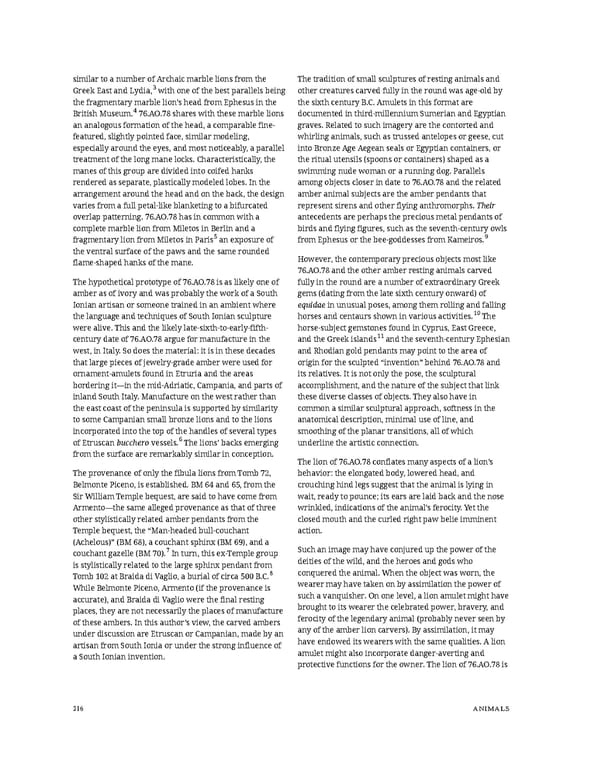similar to a number of Archaic marble lions from the The tradition of small sculptures of resting animals and Greek East and Lydia,3 with one of the best parallels being other creatures carved fully in the round was age-old by the fragmentary marble lion’s head from Ephesus in the the sixth century B.C. Amulets in this format are British Museum.476.AO.78 shares with these marble lions documented in third-millennium Sumerian and Egyptian an analogous formation of the head, a comparable fine- graves. Related to such imagery are the contorted and featured, slightly pointed face, similar modeling, whirling animals, such as trussed antelopes or geese, cut especially around the eyes, and most noticeably, a parallel into Bronze Age Aegean seals or Egyptian containers, or treatment of the long mane locks. Characteristically, the the ritual utensils (spoons or containers) shaped as a manes of this group are divided into coifed hanks swimming nude woman or a running dog. Parallels rendered as separate, plastically modeled lobes. In the among objects closer in date to 76.AO.78 and the related arrangement around the head and on the back, the design amber animal subjects are the amber pendants that varies from a full petal-like blanketing to a bifurcated represent sirens and other flying anthromorphs. Their overlap patterning. 76.AO.78 has in common with a antecedents are perhaps the precious metal pendants of complete marble lion from Miletos in Berlin and a birds and flying figures, such as the seventh-century owls fragmentary lion from Miletos in Paris5 an exposure of from Ephesus or the bee-goddesses from Kameiros.9 the ventral surface of the paws and the same rounded flame-shaped hanks of the mane. However, the contemporary precious objects most like 76.AO.78 and the other amber resting animals carved The hypothetical prototype of 76.AO.78 is as likely one of fully in the round are a number of extraordinary Greek amber as of ivory and was probably the work of a South gems (dating from the late sixth century onward) of Ionian artisan or someone trained in an ambient where equidae in unusual poses, among them rolling and falling the language and techniques of South Ionian sculpture horses and centaurs shown in various activities.10 The were alive. This and the likely late-sixth-to-early-fifth- horse-subject gemstones found in Cyprus, East Greece, century date of 76.AO.78 argue for manufacture in the and the Greek islands11 and the seventh-century Ephesian west, in Italy. So does the material: it is in these decades and Rhodian gold pendants may point to the area of that large pieces of jewelry-grade amber were used for origin for the sculpted “invention” behind 76.AO.78 and ornament-amulets found in Etruria and the areas its relatives. It is not only the pose, the sculptural bordering it—in the mid-Adriatic, Campania, and parts of accomplishment, and the nature of the subject that link inland South Italy. Manufacture on the west rather than these diverse classes of objects. They also have in the east coast of the peninsula is supported by similarity common a similar sculptural approach, softness in the to some Campanian small bronze lions and to the lions anatomical description, minimal use of line, and incorporated into the top of the handles of several types smoothing of the planar transitions, all of which of Etruscan bucchero vessels.6 The lions’ backs emerging underline the artistic connection. from the surface are remarkably similar in conception. The lion of 76.AO.78 conflates many aspects of a lion’s The provenance of only the fibula lions from Tomb 72, behavior: the elongated body, lowered head, and Belmonte Piceno, is established. BM 64 and 65, from the crouching hind legs suggest that the animal is lying in Sir William Temple bequest, are said to have come from wait, ready to pounce; its ears are laid back and the nose Armento—the same alleged provenance as that of three wrinkled, indications of the animal’s ferocity. Yet the other stylistically related amber pendants from the closed mouth and the curled right paw belie imminent Temple bequest, the “Man-headed bull-couchant action. (Achelous)” (BM 68), a couchant sphinx (BM 69), and a couchant gazelle (BM 70).7 In turn, this ex-Temple group Such an image may have conjured up the power of the is stylistically related to the large sphinx pendant from deities of the wild, and the heroes and gods who Tomb 102 at Braida di Vaglio, a burial of circa 500 B.C.8 conquered the animal. When the object was worn, the While Belmonte Piceno, Armento (if the provenance is wearer may have taken on by assimilation the power of accurate), and Braida di Vaglio were the final resting such a vanquisher. On one level, a lion amulet might have places, they are not necessarily the places of manufacture brought to its wearer the celebrated power, bravery, and of these ambers. In this author’s view, the carved ambers ferocity of the legendary animal (probably never seen by under discussion are Etruscan or Campanian, made by an any of the amber lion carvers). By assimilation, it may artisan from South Ionia or under the strong influence of have endowed its wearers with the same qualities. A lion a South Ionian invention. amulet might also incorporate danger-averting and protective functions for the owner. The lion of 76.AO.78 is 216 ANIMALS
 Ancient Carved Ambers in the J. Paul Getty Museum Page 225 Page 227
Ancient Carved Ambers in the J. Paul Getty Museum Page 225 Page 227